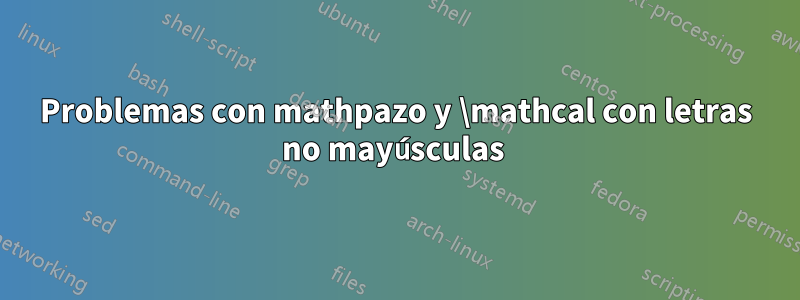
Estoy intentando utilizar la fuente mathpazo, pero tengo algunos problemas para que \mathcal funcione con letras minúsculas.
esta es mi plantilla
\documentclass[11pt]{amsart}
\usepackage{geometry} % See geometry.pdf to learn the layout options. There are lots.
\geometry{letterpaper} % ... or a4paper or a5paper or ...
%\geometry{landscape} % Activate for for rotated page geometry
%\usepackage[parfill]{parskip} % Activate to begin paragraphs with an empty line rather than an indent
\usepackage{graphicx}
\usepackage{amssymb}
\usepackage{epstopdf}
\usepackage{mathptmx}
\usepackage{accents}
\usepackage{amssymb}
\usepackage{amsfonts}
\usepackage{mathpazo}
\begin{document}
\maketitle
%\section{}
%\subsection{}
just some test $ \infty \mathcal{l}$
\end{document}
Respuesta1
Las letras caligráficas mayúsculas se asignan a la fuente cmsy10. La fuente sólo contiene letras mayúsculas caligráficas.
Versión Plain TeX para inspección de fuentes
Una fuente se puede inspeccionar utilizando testfont.texformatos simples (no LaTeX). LaTeX proporciona nfssfont.tex, derivado de testfont.tex, consulte la siguiente sección.
Ejemplo de una sesión interactiva con testfont:
$ pdftex testfont
This is pdfTeX, Version 3.1415926-2.5-1.40.14 (TeX Live 2013)
restricted \write18 enabled.
entering extended mode
([...]/texmf-dist/tex/plain/base/testfont.tex
Name of the font to test = cmsy10
Now type a test command (\help for help):)
*\help
\init switches to another font;
\end or \bye finishes the run;
\table prints the font layout in tabular format;
\text prints a sample text, assuming TeX text font conventions;
\sample combines \table and \text;
\mixture mixes a background character with a series of others;
\alternation interleaves a background character with a series;
\alphabet prints all lowercase letters within a given background;
\ALPHABET prints all uppercase letters within a given background;
\series prints a series of letters within a given background;
\lowers prints a comprehensive test of lowercase;
\uppers prints a comprehensive test of uppercase;
\digits prints a comprehensive test of numerals;
\math prints a comprehensive test of TeX math italic;
\names prints a text that mixes upper and lower case;
\punct prints a punctuation test;
\bigtest combines many of the above routines;
\help repeats this message;
and you can use ordinary TeX commands (e.g., to \input a file).
*\table
*\bye
[1{[...]/texmf-dist/fonts/map/pdftex/updmap/pdftex.map}]
<[...]/texmf-dist/fonts/type1/public/amsfonts/cm/cmr10.p
fb><[...]/texmf-dist/fonts/type1/public/amsfonts/cm/cmr7
.pfb><[...]/texmf-dist/fonts/type1/public/amsfonts/cm/cm
sy10.pfb><[...]/texmf-dist/fonts/type1/public/amsfonts/c
m/cmti10.pfb><[...]/texmf-dist/fonts/type1/public/amsfon
ts/cm/cmtt10.pfb>
Output written on testfont.pdf (1 page, 72843 bytes).
Transcript written on testfont.log.
O se puede crear un archivo de controlador para uso no interactivo:
\let\noinit!
\input testfont
\def\fontname{cmsy10}
\startfont
\table
\bye
versión látex
\mathcalutiliza la fuente de símbolo matemático (de fontmath.ltx):
\DeclareSymbolFontAlphabet{\mathcal}{symbols}
El paquete mathpazocontiene la siguiente definición de fuente para símbolos con codificación OMS:
\DeclareSymbolFont{symbols}{OMS}{zplm}{m}{n}
Los últimos cuatro argumentos son los mismos que para \usefonty son necesarios para nfssfont.tex. Ejemplo de una sesión interactiva:
$ pdflatex nfssfont
This is pdfTeX, Version 3.1415926-2.5-1.40.14 (TeX Live 2013)
restricted \write18 enabled.
entering extended mode
([...]/texmf-dist/tex/latex/base/nfssfont.tex
LaTeX2e <2011/06/27>
Babel <3.9f> and hyphenation patterns for 77 languages loaded.
([...]/texmf-dist/tex/latex/base/article.cls
Document Class: article 2007/10/19 v1.4h Standard LaTeX document class
([...]/texmf-dist/tex/latex/base/size10.clo))
No auxiliary output files.
**********************************************
* NFSS font test program version <v2.2b>
*
* Follow the instructions
**********************************************
Input external font name, e.g., cmr10
(or <enter> for NFSS classification of font):
\currfontname=
*** NFSS classification ***
Font encoding [T1]:
\encoding=OMS
([...]/texmf-dist/tex/latex/base/omsenc.def)
Font family [cmr]:
\family=zplm
Font series [m]:
\series=m
Font shape [n]:
\shape=n
Font size [10pt]:
\size=
([...]/texmf-dist/tex/latex/psnfss/omszplm.fd)
Now type a test command (\help for help):)
*\table
*\bye
[1{[...]/texmf-dist/fonts/map/pdftex/updmap/pdftex.map}]
{[...]/texmf-dist/fonts/enc/dvips/base/8r.enc}
<[...]/texmf-dist/fonts/type1/public/amsfonts/cm/cmr10.pfb>
<[...]/texmf-dist/fonts/type1/public/amsfonts/cm/cmr7.pfb>
<[...]/texmf-dist/fonts/type1/public/amsfonts/cm/cmsy10.pfb>
<[...]/texmf-dist/fonts/type1/public/amsfonts/cm/cmti10.pfb>
<[...]/texmf-dist/fonts/type1/public/amsfonts/cm/cmtt10.pfb>
<[...]/texmf-dist/fonts/type1/public/mathpazo/fplmr.pfb>
<[...]/texmf-dist/fonts/type1/urw/palatino/uplr8a.pfb>
Output written on nfssfont.pdf (1 page, 88770 bytes).
Transcript written on nfssfont.log.
El archivo del controlador para una sesión no interactiva puede verse así:
\let\noinit!
\input{nfssfont}
\def\encoding{OMS}
\usefont{OMS}{zplm}{m}{n}
\edef\currfontname{\fontname\font}
\startfont
\table
\bye
Resumen
Para letras minúsculas "caligráficas" necesita una fuente diferente y no puede usar \mathcal.




